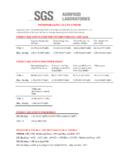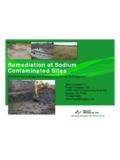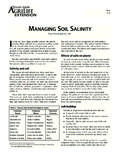Transcription of MEASURE AND MANAGE - Agri-Food Laboratories
1 MEASURE AND MANAGE High Magnesium Soils By Dale Cowan Agri-Food Laboratories Soils high in Magnesium ions are found in various locations in Ontario. Soils containing > 300 ppm of ammonium acetate extractable magnesium are considered high as well soils with Saturations >15%.. One of their observed tendencies is for these soils to become hard, form crusts and become difficult to till. These soils do respond to crop rotations that contain sod and application of animal manures or biosolids. The addition of organic matter and the resulting end product humus allow these soils to become, and remain productive by reducing stickiness and promote aggregate stability. Soils that are saturated with magnesium in our case the origin of magnesium is dolomite bedrock from which these soils were formed causes a reduction in hydraulic conductivity (HC) and infiltration rates (IR).
2 The lack of these soil properties causes a collapse of soil structure. As these high magnesium soils are managed in a cash crop environment without the benefit of manures they become progressively less productive due to poor structure. Notably potassium is also low often <100 ppm. The addition of high rates of potash fertilizers can actually make matters worse and cause even more dispersion of soil particles. Potassium and sodium have similar properties, in sodic soils sodium causes lack of structure by causing dispersion of soil particles, soils tend to remain saturated and poorly drained. It is also noted that one can not farm economically when K levels are low or medium. In high magnesium soils the magnesium ions sitting on the clay surfaces have a 50% greater hydrated radius than calcium which causes these soils to absorb more water.
3 This will tend to weaken the forces that hold soil particles to together resulting in less aggregate stability and greater dispersion of soil particles reducing infiltration rates and hydraulic conductivity (drainage). These soils tend to swell when wet and become very hard when dry depending on the dominating clay these soils may or may not crack and often form a hard surface crust. The solution is managing for soil quality with manures and crop rotation. If this is not the primary practice then applying gypsum in an effort to displace magnesium is the often proclaimed solution. Application of high rates of potash have not always show yield increases whereas small rates in the starter at rates in the 30 pound range have shown much greater response. (Trial attached from Eaststep farms).
4 I suspect that high rates of potash in the presence of high levels of magnesium (>600 ppm) probably aggravate the dispersion of soil particles if crop rotation and manure additions are not The question remains to MANAGE for soil quality with additions of organic matter or apply gypsum. Based on the CEC and Mg levels in the area applications of 1500 to 2000 pounds of gypsum / acre would be a starting point however these soils will always be more productive under a management system that adds organic matter on a regular basis by crop rotation, manure and or bio-solid additions. Crop rotations of multiple years of soybeans and wheat with straw removed are a guarantee for less than profitable farming due to less aggregate stability and degradation of soil structure due to less organic matter being added.
5 The following tables are local Ontario data illustrating K response to tillage; placement and timing of K both of these sites are high in Magnesium. The application of spring K at 25 to 45 pounds of K2O yielded as much corn as spring and fall applied K at rates of 90 to 100 lbs / acre. Summary High magnesium soils can prove to be a challenge if crop rotation, manure additions and timely tillage operations are not followed. Moderate rates of K applications are needed when potash is low to medium. Additions of gypsum are proclaimed to loosen the soil ; however this is only part of the solution. The additions of organic matter to provide the necessary biological activity to promote strong soil aggregate stability is if more importance. Creating quality soil is a nurturing process.
6










